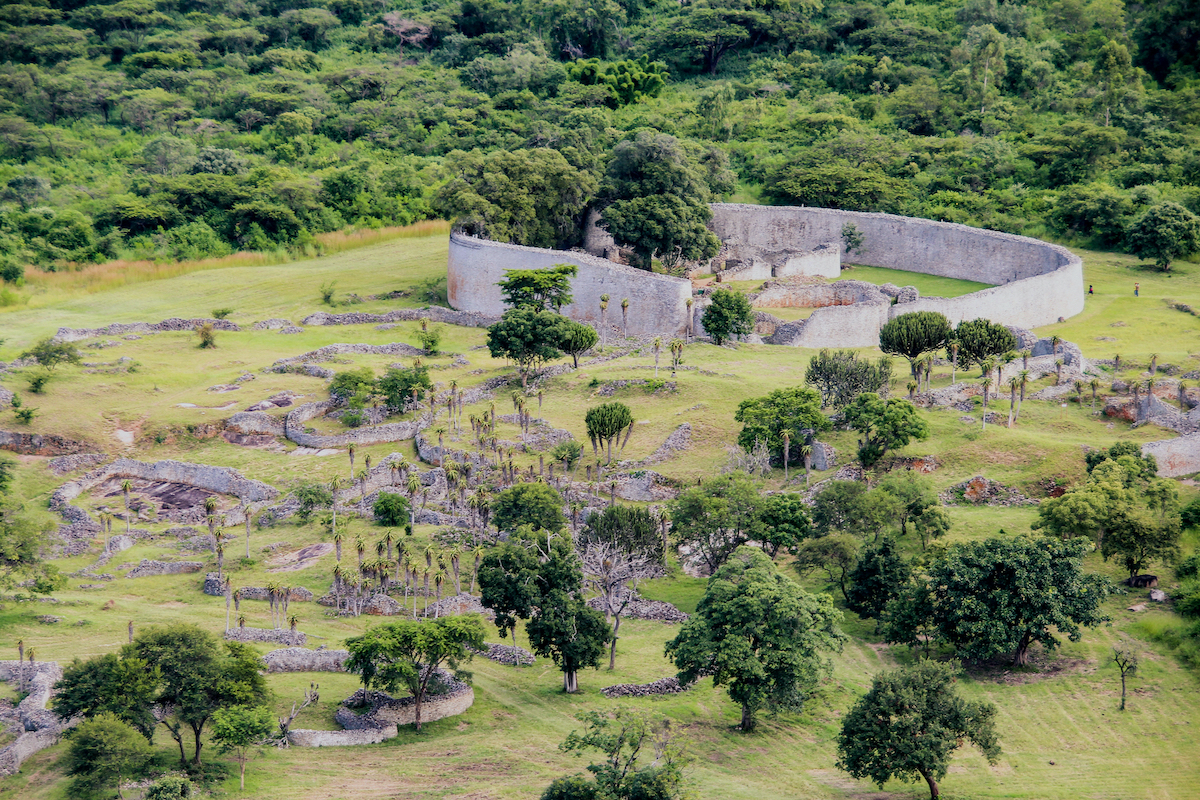Here you can track monkeys, buffalo and rare hippos; pick your own oysters fresh from the sea; dine on an unspoilt, empty beach with only the moon for company; step onto a former slave island drenched in history; and camp in a last, treasured patch of rainforest.
Katrina Manson & James Knight authors of Sierra Leone: The Bradt Guide
Sierra Leone has seen a heartening recovery since emerging from a civil war a decade ago, and is making a determined push towards eco-tourism. It inspires many feelings in those who visit: wonder at its natural beauty and extraordinary wildlife, heartache for its past suffering, and joy in its enduring spirit and sense of fun. Take a trip to Sierra Leone’s infamous diamond mines and rainforest-covered mountains; go in search of the elusive pygmy hippo; or simply relax on the country’s beaches and islands.
From the wingflash of an emerald starling, to the shouts of the star-fruit seller in the market, to the salty fur of the ocean, Sierra Leone gleams with life, brilliance and pain.
Salone, as it is affectionately known (and Sweet Salone for extra affection), is not always an easy country, or a happy one. Plenty of things don’t work, and won’t work for a good while yet. Energy, water, roads, education and healthcare – these basics are erratic, if present at all. Travelling across the capital is tough, let alone going a few miles down the coast or trekking upcountry.
But Sierra Leone’s love of life, the determination to make something of itself, even while it shuffles near the bottom of the UN’s human development index, shows a spirit the world should gasp at. Young rappers sing of their love of peace, nature-lovers strive to protect rare species, fashion designers pioneer African looks, campaigners agitate for for justice and health workers, now and during the recent Ebola epidemic, bravely care for their communities, often in the direst of circumstances.
In short, Salone keeps trying: after all, this is the place with a rousing history so full of fortitude that it took three waves of former slaves to found the capital in their search for freedom.
It is not yet a ‘destination’ in the travel industry sense of the word. Once a playground for the French jetset, and adventurous couples in search of an untrammelled paradise, today only 10,000 of 54,000 annual visitors a year call themselves tourists. While this book is for that growing number of intrepid spirits, it is also for the other 44,000: primarily those in the Sierra Leone diaspora visiting friends and relatives, perhaps thinking they might just come home for good this time; and for the business people, development workers and diplomats who come to stay for a while.
More than any outstanding vista, perhaps the greatest pleasure, and privilege, lies with some of the extraordinary people you may meet. We try to tell a fraction of their stories, but thousands more exist far beyond these pages. This guidebook is a jumping-off point: it is not exhaustive, and Sierra Leone never stands still long enough for all of what we have said here to apply in six months, let alone two years. Ask questions, and listen to the people around you.
‘We need people to know that Sierra Leone is a destination that is safe, in spite of the fact that we have come out of war. There’s no mayhem in the streets,’ Cecil Williams, former manager of the National Tourist Board, told us on one of our trips.
His favourite story revolves around five travel journalists who were meant to visit. Prior to arriving, two backed out because they were too scared to come. ‘The first night I took them out and by one o’clock I went home,’ he said, with the beginnings of a smile. ‘The next day I found out they had stayed out until four in the morning and they had never felt so safe. They did it every day until they left.’
For more information, check out our guide to Sierra Leone
Food and drink in Sierra Leone
Staple dishes
You may hear the phrase that a Sierra Leonean has not eaten unless he’s had rice. Pile on the salad, protein or sweets, but a Salone man will still walk away hungry unless he’s had a plate of the stuff. There are more than 20 different Mende words to describe rice in its variant forms, from ‘sweet rice’ to ‘pounded rice’ to ‘the rice that sticks to the bottom of a pot upon cooking’. Relying on white imported rice from India, Pakistan and Thailand, world price rises have hit the country hard, although ‘country rice’ – the brown chubby version – is also popular upcountry among subsistence farmers.
The classic dish of the nation is rice and plassas (also called palaver sauce), a word to describe any of the various green leafy sauces, drowned in fatty, lip-staining orange palm oil (also known as pamine), which can leave a scratchy taste in the back of the throat. Among the most popular options are cassava leaf sauce, potato leaf sauce (both a bit like spinach) and slimy crain crain, described by one smiling detractor as ‘reminiscent of the middle of a cockroach’. (If crain crain is served with a rich pamine sauce, it’s known as obiatta.) Whatever the main ingredient, the sauce is usually cooked with onions, fresh chillis and stock cubes. An unusual taste at first, it doesn’t take long for the homely, filling nature of rice and plassas to take on a comfort of its own. Palm oil can give everything a bitter or overly fatty taste, and some prefer to use coconut oil or groundnut oil. If ever you’re asked if you’d like your plassas ‘white’, it means having a clear oil – taken from the nuts inside the kernels rather than the soft pulp surrounding them – instead of the usual red palm oil. If you’re vegetarian, watch out. Just because a sauce is described by the relevant type of leaf that doesn’t mean you won’t find meat in there – chicken, beef, goat, grasscutter, duiker or monkey (depending on how rural and remote you are) and smoked fish are all favourites.
A sweeter alternative is the Salone version of satay – a groundnut sauce (often called a soup or stew) and made from peanuts, with whatever animal is to hand thrown in. The thicker the sauce, the better.
All these dishes are usually riddled with chilli pepper, so be sure to speak up if you’re not a fan of having your head blown off, although as dishes are often served from giant pots there’s not much the cook can do to tone things down. Another popular rice dish is jollof rice, cooked with tomatoes and onions, spices and stock. A much subtler flavour, it’s sweet, moreish and often cooked on special occasions.
The other key carbohydrate is cassava. Chunks of flaky cassava with black-eyed beans (pronounced ‘binch’) are hard to beat. Gari – grated cassava – is popular in the second city, Bo. Strong on texture, it’s less bland than foofoo, also made of cassava, which is ground up, mixed with a little water, pushed through a sieve, cooked over a slow fire into a thick paste, and then rolled into balls. Foofoo tends to be eaten with palm-oil stew or ebu as an alternative to rice. Roast cassava is heated over hot coals. The roadside traders of Waterloo, just outside Freetown, have a fine reputation for thin discs of cassava bread with a hot fish sauce. Sweet potato, pasta (from packets) and chips are found on most Freetown menus. If you still feel there aren’t enough carbs in your diet, do not miss the chance to try street-sold Fula bread, rich, fluffy and almost baguette-like. For Le1,000–4,000 a stick, from wooden boxes carried high on vendors’ heads, you can’t go wrong. Much of the bread sold in shops is grim, and imitation croissants are mostly an embarrassment (with a few exceptions).
Side dishes
Other local accompaniments include fried plantain (sometimes roasted or boiled) and bitter okra sauces with rice. Beans and plantain is a dish in itself, fatty, filling and delicious. African salad can sound marvellously exotic. But in place of passion fruit and unknown fresh-picked leaves, it generally translates as ‘straight out of a tin’. The base is often luncheon meat, ketchup and mayonnaise, with some tasteless tinned vegetables and possibly a boiled egg and some tuna thrown in.
Street food
All towns have a road or two lined with wooden food stands. Favourites include fried and breaded chicken; grilled meat (skewered beef, chunks of liver and heart, and goat are popular); chunks of grilled snail with raw onions and groundnut sauce; cutting grass, or grasscutter (bush rat), fried yams, sweet potato and plantain; eggs, whether boiled, fried or even scotch; and attieke, a medley dish of the ubiquitous cassava (this time fermented, crushed and steamed to resemble couscous), chicken or meat if available, chopped-up spaghetti and whatever else might be to hand, such as onion or tomato and hot pepper. Everything comes with lashings of mayonnaise (Le300) and ketchup (Le300). Fry fry refers to any of the contents you might end up putting in your bread, such as beans. Upcountry, look out for entire grilled bush ‘fowl’, a small local chicken, and porcupine soup. The more remote you go, the more likely you are to come across bushmeat. At transport stops there are fairly regular offerings of grasscutter sandwich, as well as dead monkeys hung up on wood-stick tripods at roadsides and the odd deer leg and porcupine sold at market.
In shacks, bread with condensed milk is popular, and many people pour the milk straight from the can onto the bread for breakfast, adding an egg in some form if any are available. Others dip their bread into seriously sweetened tea, coffee or cocoa.
Cookeries – often no more than wooden shacks offering a bit of shade from the sun – serve up rice and sauce. In the most humble of them, you can request a plate size according to price (usually Le2,000 or Le4,000 per plate), other grander affairs charge set fees that do not usually exceed Le6,000. For the same meal in a restaurant, expect to pay Le25,000 or more.
Snacks
Don’t miss pounded corn, a sugary yellow paste wrapped in kola leaf sold for Le200 a bundle. It’s a shot of energy for the afternoon post-rice lull. Popcorn and roasted corn on the cob are also popular.
Morko makes for a sweet breakfast – a deep-fried mixture of ground rice with banana. Or try various akaras: beans or rice ground up, made into a ball and boiled or fried. Likewise fish balls, also for Le200 each, are a quick energy burst.
Biscuits include benni cake, made from a bitter plant and sugar and shaped into a diamond; coconut cake; bulgar cake, made from wheat; kebbe, rolled into a ball; and brittle groundnut cake.
Less a snack and more a social tool, the kola nut figures heavily in local shows of custom and respect. It’s a ceremonial lynchpin, time-passer, dye and mini-high all in one. ‘He who gives kola nut gives life,’ goes the saying, and this bright purple, smooth nut from the kola tree is a perfect offering for chiefs and elders. Breaking one in two or biting off a small piece and then sharing it around are established ways of building trust and unity, but take your lead from your company. While many foreign visitors mistakenly sometimes come laden with kolas as gifts for the local chief, by tradition they are in fact given from the host to strangers. Otherwise it’s a bit like bringing coal to Newcastle, and will be seen as a bit cheap too, quite frankly.
Drinks
Hard stuff
Booze is a mainstay of village life, with homemade moonshines the norm. Best known is poyo, or palm-tree wine. Distil poyo and you have the clear spirit omele, so hard it also goes by the name of ‘bush kerosene’; not only will it make your eyes water, they may feel like they are about to pop out of their sockets.
Manpikin (man-child) is the name of the rather less appealing local rum; be warned, it doesn’t give you the bulging biceps of the hastily drawn figure in the promotional pictures – you’re more likely to be turned into a dribbling fool, as the name suggests. Shot-sized clear plastic tubes, called Pegapak, contain neat gin and sell for Le500. Look down and you’ll see the ground of some villages strewn with the discarded packets.
Beer is widely available. The local brew, Star, comes in green bottles and chubby cans. They can go for as little as Le4,000, depending on where you’re buying, but more often Le6,000–8,000. Most beers are served with a paper napkin, so you can wipe down the recycled bottle rim. Taste varies depending on the batch, but generally it’s slightly heavier than the imported beers – Heineken, Carlsberg and Becks – which usually sell for at least twice the price, making them the brands of choice for well-to-do Sierra Leoneans. Guinness enjoys affection, based mostly on the memory of the now-banned adverts suggesting it offers ‘strength’ (often interpreted as sexual potency). The newest beer on the market, Salone Beer, hit shelves at the end of 2016 and is notable for being brewed from 100% locally grown sorghum rather than imported barley.
Soft stuff
Bottled Coca Cola, Fanta and Sprite are all present; there’s also sticky-sweet purple Vimto and energy drinks – Red Bull, Battery – to keep Freetowners going into the early hours. Malt drinks are also popular. Locally produced equivalent colas tend to be slightly sweeter and cheaper; some bars stock a range of imported juices. Sadly there’s not yet a large-scale outlet for the country’s exotic fruits, but some bars do sell delicious freshly squeezed juice, whether mango, pineapple, banana or in one rather extraordinary case, avocado (head for Bliss Patisserie in Freetown to sample that one). Oasis Café in Freetown sells an innovative range of juices and icy brews. Try the gingered iced tea or the mint-laced watermelon juice for a refreshing quaff.
While thick, strong Turkish-style coffee is a favourite among the Lebanese community, green tea is the brew of choice in the provinces. Known as ataya it is served in small short glasses with a healthy dose of froth on top, often from wooden stands that, like poyo shacks, serve as popular meeting points – look for the sign Ataya Base. In the bush, ataya is often shared, and the more froth you’re offered the greater the honour.
Tap water isn’t safe enough to drink – never mind the quality of the water treatment, the pipe network is filthy and often exposed. If cooking, boil first for at least a minute and add purifying tablets if you have them.
Bottled water is sold in all supermarkets, with a range of French and Lebanese imports. To support the local stuff, buy Blue Spring, Grafton, Luvian or Magram, bottled fresh from the local springs. A six-pack of 1.5-litre bottles costs from Le18,000. You can also buy plastic sachets of water all over the country – bar the villages that rely on well water (often cleaner than tap water) or (less reliably) the nearest stream. They sell for Le500 each. Some street-sellers offer much cheaper cold water in unmarked plastic bags – this is chilled untreated water and should be avoided.
Health and safety in Sierra Leone
Health
Preparations
Sensible preparation will go a long way to ensuring your trip goes smoothly. Particularly for first-time visitors to Africa, this includes a visit to a travel clinic to discuss matters such as vaccinations and malaria prevention.
- Don’t travel without comprehensive medical travel insurance that will fly you home in an emergency.
- Make sure all your immunisations are up to date. It is wise to be up to date on tetanus, polio and diphtheria (now given as an all-in-one vaccine, Revaxis, that lasts for ten years), and hepatitis A. Proof of vaccination against yellow fever is needed for entry for all travellers in to Sierra Leone regardless of age or where you are flying from. The yellow-fever vaccine is very rarely given before nine months of age as there is an increased risk of severe vaccine reactions before this age. Since July 2016, any yellow-fever certificate is considered to last for life if you are over two years of age and/or you are not immunosuppressed at the time of having the vaccine. If either of those criteria applied then revaccination is recommended at ten years. If the vaccine is not suitable for you then you would be wise not to travel, as West Africa has the highest prevalence of yellow fever and there is up to a 50% mortality rate. If the traveller insists on going then they will need a yellow-fever exemption certificate.
- The biggest health threat is malaria. There is no vaccine against this mosquito-borne disease, but a variety of preventative drugs is available, including mefloquine, malarone and the antibiotic doxycycline. The most suitable choice of drug varies depending on the individual and the country they are visiting, so visit your GP or a travel clinic for medical advice. If you will be spending a long time in Africa, and expect to visit remote areas, be aware that no preventative drug is 100% effective, so carry a cure too. It is also worth noting that no homeopathic prophylactic for malaria exists, nor can any traveller acquire effective resistance to malaria. Those who don’t make use of preventative drugs risk their life in a manner that is both foolish and unnecessary.
- Though advised for everyone, a pre-exposure rabies vaccination, involving three doses taken over a minimum of 21 days, is particularly important if you intend to have contact with animals, or are likely to be 24 hours away from medical help.
- Anybody travelling away from major centres should carry a personal first-aid kit. Contents might include a good drying antiseptic (eg: iodine or potassium permanganate), Band-Aids, suncream, insect repellent, aspirin or paracetamol, antifungal cream (eg: Canesten), ciprofloxacin or norfloxacin (for severe diarrhoea), antibiotic eye drops, tweezers, condoms or femidoms, a digital thermometer and a needle-and-syringe kit with an accompanying letter from a health-care professional.
- Bring any drugs or devices relating to known medical conditions with you. That applies both to those who are on medication prior to departure, and those who are, for instance, allergic to bee stings, or are prone to attacks of asthma.
- Prolonged immobility on long-haul flights can result in deep-vein thrombosis (DVT), which can be dangerous if the clot travels to the lungs to cause pulmonary embolus. The risk increases with age, and is higher in obese or pregnant travellers, heavy smokers, those taller than 6ft/1.8m or shorter than 5ft/1.5m, and anybody with a history of clots, recent major operation or varicose veins surgery, cancer, a stroke or heart disease. If any of these criteria apply, consult a doctor before you travel.
Travel clinics and health information
A full list of current travel clinic websites worldwide is available on www.istm.org. For other journey preparation information, consult www.travelhealthpro.org.uk (UK) or http://wwwnc.cdc.gov/travel/ (US). Information about various medications may be found on www.netdoctor.co.uk/travel. All advice found online should be used in conjunction with expert advice received prior to or during travel.
Safety
Despite the raised eyebrows and occasional grunts of disbelief that greet the news that you are daring to venture into a one-time warzone and epidemic hotspot, Sierra Leone is today among the safest countries in Africa. Honestly. All arms are now banned from civilian use. United Nations troops left at the end of 2005, and the British-led International Military and Advisory Training Team (IMATT) concluded their mission in 2013. Today IMATT’s successor, the International Security Advisory Team Sierra Leone (ISAT), focuses on advising Sierra Leone’s emergency and security services, including the fire brigades, prison service and coast guard. The UN Integrated Peacebuilding Office in Sierra Leone (UNIPSIL) completed its mandate in 2014, and now the UN is active here only as part of the United Nations Development programme (UNDP), sponsoring poverty eradication and inequality reduction programmes.
Crime
Serious crime is relatively low and most people enjoy their stay with no problems at all. Many houses within compounds are guarded by round-the-clock uniformed guards and perimeter walls are often topped with rolls of barbed wire or broken glass. Very occasional armed attacks on households have occurred, but they tend to be targeted and do not normally involve visitors.
Petty crime, pickpocketing and armed mugging are sadly more common, and while still relatively rare overall they are likely to rise in line with urban poverty.
Don’t make mistakes you would never dream of making at home, such as leaving room doors unlocked, or expensive items on show – things will disappear. Plus, if something goes wrong, don’t despair of everyone. A young couple, having had a couple of bags stolen, were approached by the caretaker of the convent they had been staying in. ‘There are some really bad people in Sierra Leone,’ he said, taking them by the hand as a tear ran down his cheek. ‘But don’t forget there are some good ones too.’
Among the few potential trouble spots is the Lumley–Aberdeen beach strip in west Freetown after dark. Muggings and car break-ins are common, and phones, iPods and wallets are regularly stolen. The very southern end near the Golf Club (a regular escape route) is often targeted. Early-morning joggers and anyone on the beach from dusk onwards are at risk, with occasional threats at knifepoint. Save moonlit strolls for the Peninsula. All beach bars, however, are fenced off, with plenty of workers and customers, and are perfectly safe.
Most of the time being on foot downtown attracts a lot of attention, from petty traders, moneychangers and beggars. While some can turn thief quickly, it’s not generally a dangerous place to be in daylight hours. The national stadium – which can seat 40,000 people – offers a field day for light fingers. Burglary, sometimes armed, and street robbery spike in the lead-up to Christmas.
The only thing worse than being robbed is seeing what happens if some poor unfortunate is caught: mob justice looms large on the streets of Freetown, where suspected thieves can be beaten up, belted or worse by angry bands at a moment’s notice. Shout ‘thief’ (or, in Krio, ‘teefman’), and people are likely to give chase, and land some pretty hard punches too if they can. In rare instances teefmen have been beaten to death. The east end is considered the most dangerous part of town, with higher crime rates, and walking in the area after dark is ill-advised.
Female travellers
In rural areas, women should find it possible to travel on their own without encountering too much hassle. Although you are likely to be a constant object of attention, which can be wearing, respect tends to be uppermost in people’s minds. In towns, however, it’s not uncommon for men to accost women out of nowhere with phrases such as ‘I like you’, ‘I want you for friend’ and, pushing the boundaries even of Romeo-esque passion, ‘I love you’. In all cases this pretty much means they want to get it on or, sometimes just as usefully, get a visa.
Claims of a boyfriend or husband, or a strategically placed ring marginally decrease interest, although often this isn’t seen as at all relevant given your assumed mutual ardour, alongside a rather lax interpretation of fidelity. It’s fine to be firm: you won’t offend someone by making your ‘no’ unequivocally clear. As one experienced traveller put it: ‘a sense of humour and willingness to chat rubbish helped, as did claiming not to own a mobile or that it was for work.’
Often, when travelling on buses and other transport, it makes sense to try and build rapport with another friendly-looking woman and, if in doubt, follow her lead. While wearing vest tops tends to be fine, exposing knees or excessive cleavage can be seen as uncouth upcountry. Tampons are available in supermarkets in Freetown, Makeni and Bo but not elsewhere. Sanitary towels are widely available in shops and even market stalls in reasonably sized towns nationwide.
Travel and visas in Sierra Leone
Visas
Beside the usual visas, jabs and health certificates, you still officially need to be invited to the country. No casual encounter here; this is a full-on formal date. If you are going to visit a friend or contact in Sierra Leone ask for a short letter from them. If you are going on a genuine holiday, then arrange one through your tour operator or hotel.
Some bodies, such as Visit Sierra Leone and IPC travel agency, offer fast-tracked tourist board-approved services to skip this archaic letter-writing hurdle. Go to Visit Sierra Leone for an up-to-date list of visa prices, as well as information on how to secure your visa in advance without visiting your local Sierra Leone high commission or embassy – scan the relevant passport page, provide your name and dates of travel, and let Visit Sierra Leone do the hard work, for an admin fee of US$30. It’ll be a single-entry, one-month visa, and you pick up a scan of it via email and carry it in your passport.
Getting there and away
By air
Sierra Leone’s airport, Lungi International, isn’t actually in Freetown, but in fact on the opposite side of the water in Lungi. Several international airlines pulled their Freetown routes during the Ebola crisis and not all of them had returned at the time of writing. The most notable absence is that of British Airways, who suspended their route in 2014 – rumour on the street is it was an unprofitable route to begin with and Ebola provided a convenient pretext to axe the service.
A hastily arranged substitute meant to serve the London–Freetown route, Fly Salone, both started operations and collapsed within a four-month period in 2015–16, and Sierra Leone remains without a direct air link to the UK. It’s not all doom and gloom in the air sector though; KLM introduced new direct flights from Amsterdam in March 2017, Fly Mid Africa started services to Banjul that May, Mauritania Airlines added Freetown to their Dakar–Conakry route in August, and Turkish Airlines was in negotiations to start offering connections to Istanbul before the end of the year. According to the Minister of Transport and Aviation, Emirates are considering adding Freetown to their network as well.
You can generally pick up a return from the UK for about £700, although deals at certain times of the year can see them drop below that – for example, a month-long return from Freetown at Christmas might go for as little as £500 – while in summer months prices can rocket.
Most international flight tickets already include US$40 departure tax, but local flights tend not to, so be prepared to stump up the extra cash at the airport.
Should they resume, direct flight time between the UK and Sierra Leone is only about 6 hours. Not the most favoured of worldwide destinations, many planes depart Freetown horribly late at night, leading many a confused ticket-holder to arrive a day late for their 02.00 flight. Be prepared too for lengthy delays.
In 2006, the EU banned many African carriers from landing in Europe, although that obviously doesn’t stop airlines that don’t meet European safety standards from flying within their own region – something to bear in mind when you book your tickets. You can check the updated list at here.
By road
Long eschewed by overland travellers thanks to years of turmoil in neighbouring Liberia and Guinea, the newfound political calm in the Mano River neighbourhood means it’s now easier than it’s been for decades to enter Sierra Leone by land. Whether that means bouncing through the pretty hills and mountains of rural Guinea, or grinding along the steaming swamps and jungle of Liberia, it makes for a pretty spectacular way to arrive.
While the state of the roads and the sheer unpredictability of the environment mean it’s no picnic, a road trip to Sierra Leone is certainly not impossible. Make sure you possess Job-like reserves of patience (and charm) to deal with ubiquitous police checkpoints, the only thing south of Tangiers more prominent than Premiership football shirts. Driving down from Europe, hugging the coast via Morocco and Mauritania on tarmac roads to Dakar, takes about three weeks. The Bradt Africa Overland guide has some good advice about kit and other essentials.
Border crossings and checkpoints
Crossing into Sierra Leone itself is relatively straightforward. The simplest way from the north is via Conakry, the Guinean capital, from where the border is a couple of hours away at Pamelap, on a poorly maintained tarred road that continues to the Sierra Leone town of Kambia.
Following the border about 100km northeast, the crossing at Madina Oula is more difficult thanks to the poor state of the roads; it’s 65km from the Guinean city of Kindia, which is itself about 3 hours northeast of Conakry. It offers direct access to Outamba-Kilimi National Park once over the border in Salone, but you’ll have to take ocada transport for at least part of the trip.
There’s also a great route into the far northeast of Sierra Leone from near Faranah in Guinea, east of Falaba – good if you’re sweeping down south from Mali. Border officials at Gberia Fotombu (also known as Koindu Kura) are courteous and keep the post open 06.00–18.00, with fairly hassle-free paperwork.
Heading into the east of Sierra Leone, the main border crossing from Liberia is at Jendema, linked to the Liberian town of Bo-Waterside by the Mano River Bridge. From here the road to Monrovia is tarred and in a good state of repair, and you can reach the capital in a couple of hours.
There’s also a pair of decidedly remote crossings in Kailahun district, either at Baidu, near Koindu, or Dawa, near Buedu, from where it’s 17km and 25km onwards to the Liberian town of Foya, respectively, on rough roads all the way through.
By sea
The regular ferry service between Freetown and Conakry has long been out of action, although there are occasionally hopeful rumours of it starting up again. Cargo and passenger ships berth at the Queen Elizabeth II Quay, while some passenger/cargo and private craft can land at Government Wharf in Central Freetown, arriving most often from Conakry and Banjul. Enquires should be made to cargo shipping agencies via the Sierra Leone Ports Authority. Also contact Sea and Land Services, Sierra Leone Shipping Agencies and the Sierra Leone National Shipping Company.
Getting around
Traffic drives on the right, a shift made in 1971 to keep pace with neighbours and fellow right-handers Guinea and Liberia, as well as an attempt to shed the yoke of colonialism. Drivers stuck notes all over their cars to remind themselves, and some radio jingles had people so on-the-ball they switched lanes ahead of time, with disastrous results. Today you could be forgiven for thinking that many people still aren’t quite sure, as cars overtake into oncoming traffic, and hazard lights are switched on by those in a hurry as an apology for doing whatever they like.
Accidents are common, and transport is often in a state of ill-repair – think nothing of vehicles with cracked windscreens, missing mirrors and no seatbelts, with so much paraphernalia piled up on the dashboard (family photos, fake flowers, encouraging cards, plastic toys, totems) that it’s hard to see out anyway. Roads upcountry are often dire and particularly dangerous during and directly after the end of the rainy season.
By poda poda
Poda podas are the backbone of the public transport system. Perhaps it’s no surprise then that the phrase is often taken to mean ‘slowly slowly’. These wood-slat-seated minibuses travel on numerous fixed routes, and in central Freetown, this usually means the most congested roads. They pick up and drop off on request, and are easily hailed. Crammed with people, they are also among the best places to find out the latest music hits.
By taxi
For those without transport, taxis are the easiest way to get around. You can spot them by their yellow sides, although there are a few magnificently incongruous black and red London cabs plying routes too. You can hail one whenever you see it, but bear in mind they are shared and tend to keep to fixed routes. Shout out your destination and be prepared to be refused if it’s not in the right direction. Learn the key routes and in your head combine them in order to reach your destination.
Taxis are priced by the distance you travel. ’One-way’ costs Le2,000 (although this rises in line with petrol price hikes), but is a variable unit of distance (roughly 1–2km). Expect to be overcharged the first few times you use a taxi, and watch how much other passengers pay to get a feel for how far Le2,000 will take you.
By motorbike
Sierra Leone is also home to the motorbike taxi – hop on the back, hold on, and go. Known locally both as Hondas and ocadas, they are most popular in the provincial towns of Bo, Makeni and Kenema, but pop up in other towns such as Kabala and Koidu. In Freetown they are a handy way to dodge the traffic in the east of town, and to head out from Lumley to get to the beaches on the Peninsula.
By car
For travel within Freetown or between regional capitals, a car is fine, but beyond it a 4×4 is a prerequisite. That means either having your own, cadging lifts or hiring – a super expensive option. Fuel is available in most towns, but often from old pumps, and can be full of impurities. Try to fill up in Freetown and provincial capitals where possible.
When to visit Sierra Leone
Common advice is that November and December are the best months to visit, because of the welcome combination of very little rain and less fearsome heat. The disadvantage towards the end of this period is the haze created by the harmattan – the desert wind that picks up sand and dust as it comes in over the Sahara – in December and January, sometimes until March. The effect is less choking than countries nearer the desert, but you won’t see crystal blue skies. February and March are also good months to visit, warm and dry, while April and May see the hottest weather before the rain arrives around June.
During the wettest months of July and August and for some while after, access to more remote rural areas becomes almost impossible, as dirt roads are turned into mud pie by torrents of water. Rains arrive with spectacular force, but not every day is wet or overcast. Between downpours, with the dust bedded down, the water washes the light clear and strong and the skies blue, making the beaches their beautiful best at the end of the season, around September and October.
Climate
For a country that basically has two seasons – wet (May to October) and baking (November to April), it’s extraordinary that Sierra Leone rivals the UK as far as conversations about the weather go. Perhaps that’s because the tiniest deviation from this binary seasonal experience is such a shock to the system, and can so easily affect agriculture for its many farmers, that every nuance counts.
Umbrellas can be seen year-round – acting as a shield first from the unyielding sun, and then the thrashing rain, but both elements are so extreme that they don’t do much good. Hot and dusty months come during the stretch between November and February (worst during December and January), when the harmattan winds arrive full of Saharan sand, blotting the sky, and carpeting the land with dust. Coughs and sore throats increase, and people can usually only manage a whisper of ‘harmattan’, by way of explanation. The sizzling months come in March and April, when temperatures can reach 38°C. Most of the time the temperature deviates little from 27°C to 30°C, although in some inland areas such as Kabala, temperatures can drop at night.
Despite the lack of rain in these six months, it’s a bit of a cheek to call it the ‘dry’ season. Sweaty season is more like it: do nothing but breathe, and you can expect to be drenched. In Graham Greene’s Heart of the Matter, which is set in Sierra Leone, characters are forever writing with blotting paper under their hands to prevent the ink from smudging. While air temperatures only hug the 30°C mark, humidity upwards of 75% (ranging from 69% in January to 82% in August) makes the going pretty excruciating. If you’re on the coast, the sea breeze does provide some respite, particularly in the evenings, but you have to be on the beach to derive much benefit.
What to see and do in Sierra Leone
Bo
Sierra Leone’s second city, and capital of the province, is known as the country’s party town – Manchester to Freetown’s London. That’s partly because it’s a student hive, and partly due to the high number of diamond dealerships here. It’s lost some of its razzle-dazzle, but once upon a time fun-lovers (and would-be lovers in general) would head here for the weekends, Freetown’s cliquey social circles left far behind. Home to Njala University’s Bo campus, it’s full of radical, enthused young people, who are determined to make the most of their studies. It’s also the country’s gari capital. While the casual visitor might be nonplussed by this fact, it’s well worth knowing much of the rest of the country goes mad for it; making a beeline for the women who sell plastic bags of flaky, off-white grated cassava on rickety wooden stalls by the side of the Freetown–Bo Highway, and coming home with as many sacks as they can carry. Wide, flat streets contrast with the capital, making Bo a less traffic-heavy place to get around.
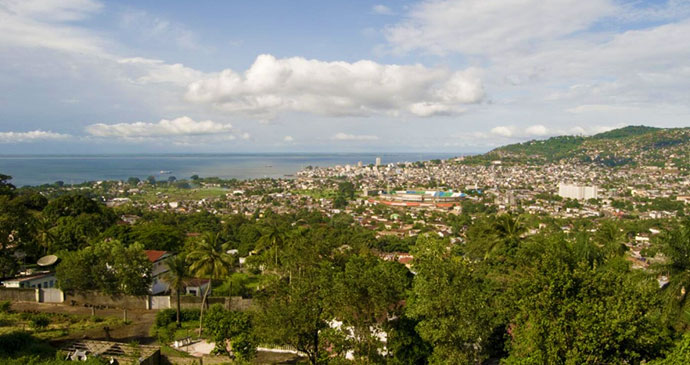 Between the jungle and the sea, the streets of Freetown are a colourful hotch-potch of architecture © National Tourist Board of Sierra Leone
Between the jungle and the sea, the streets of Freetown are a colourful hotch-potch of architecture © National Tourist Board of Sierra Leone
Freetown
Set amid jungled mountains and a sweep of beach, Freetown has among the most improbable layouts of capital cities, all tangled roads snaking back and forth, keeping pace with the hills and wandering ramshackle around the coast. Brightly painted wood-slatted houses are draped over gorgeous green hills, sneaking down to a sea lined with beaches perfect for family outings, a kickaround, a swim or a cold beer. On a clear day, the picture is stunning.
While there are a few ‘sights’, the real draw of the capital is its atmosphere – sometimes almost suffocating in its hectic pace and dazzling in its brightness. But beneath the surface, history is everywhere, charting the birth of a home for freed slaves.
Freetown today is a city of small districts, which can take up just a handful of streets, each with a distinct character and a name borne of the communities that marked them as their own: Kissy for the Kissi farmers of the east; Congo Cross after the freed slaves of that country who were delivered here; Cline Town from liberated Hausa slave Emmanuel Cline, who in 1839 wanted to start a religious colony back in Nigeria; Kroo Town for the Kru fishermen of Liberia; and PZ after the Scottish-Greek trading partnership Paterson Zochonis that set up shop at the now-famous downtown intersection. Amid this patchwork of neighbourhoods is a larger rivalry between the poorer east and richer west sides of the city, which can take on epic proportions; with fashion shows, hiphop battles and beach parties all devoted to the difference.
For a town with freedom built into its name, hardship, struggle and the sort of poverty that can almost seem to render freedom meaningless are part of daily life. The city can sometimes seem hedonistic without reaching optimistic; people party to forget, sometimes they go out just to be seen. But what a party. Street parades, album launches, packed night-time beach bars and grinding dancefloors with floor-to-ceiling mirrors form partners in vanity. Most places don’t really shape up until way after midnight, and staying out until first light is common. And there’s always the warm embrace of a hammock on a beach to play out what’s left of the next day.
The city lives by contrasts – the traditional devils that dance on one side of town while a Jesus march takes place on the other; the fast-paced shouting matches that halt traffic but somehow never descend into violence; the fishermen heading out to sea in the dead of night as clubs still heave with enthusiastic bodies.
The city lives by contrasts – the traditional devils that dance on one side of town while a Jesus march takes place on the other; the jobless boys who cross-train with such discipline on the beach every morning; the downtown market trading women who move like princesses with eight baskets of charcoal stacked on their heads; the students who throw themselves into politics with as much fury as they whoop at the beauty pageants that lift their spirits; the fast-paced shouting matches that halt traffic but somehow never descend into violence; the fishermen heading out to sea in the dead of night as clubs still heave with enthusiastic bodies; the mangoes and bright Africana cloth next to shocking pink pigs’ trotters and secondhand bicycle parts; the ice cream melting in tiny plastic bags; and the young man selling face towels just as the beads of sweat start rolling.
And Freetown goes on; improving little by little, accompanied by grumbles but rarely rage, and largely safe. However, progress is slower than many would like. Supply of water, roads, light, energy, healthcare and education will be shaky for a long time yet. The gridded basin of the central business district is enclosed by achingly poor slums, threaded with tens of thousands of plastic bags, household rubbish and abandoned machinery that collect below sea level alongside the pigs swilling in the dirt. Meanwhile faux-Doric columns go up on the well-to-do hillsides of Hill Station. The city doesn’t make sense, but you can’t help trying to fathom it.
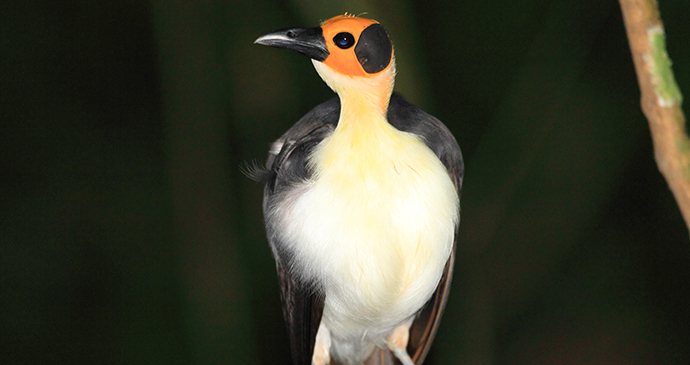 Gola holds up to 30 nesting sites for the white-necked picathartes © feathercollector, Shutterstock
Gola holds up to 30 nesting sites for the white-necked picathartes © feathercollector, Shutterstock
Gola
Parliament’s 2011 legislation that created the 71,000ha Gola Rainforest National Park came as a relief to conservation groups that had for years been calling for action to try to safeguard Sierra Leone’s last truly untouched patch of tropical evergreen rainforest.
Ravaged by rebel groups during the war, logged extensively between the 1960s and mid 1980s, and exploited in pursuit of the lucrative and well-established bushmeat trade with Liberia, the forest has finally earned the protected status that it has so long and so sorely needed. Among the last pristine rainforest in West Africa, the forest was given a clean bill of health during a 2008 flyover by wildlife-lovers, when a helicopter set off from British ship HMS Endurance, which was surveying the state of conservation along the coast. This is a boon for a country with fast-disappearing forests. Once upon a time, up to 70% of Sierra Leone was covered in forest; at the time of independence in 1961, it was 40%, while today only 5% of this original cover remains. A further 33% of the country is covered in secondary growth forests, and 11% of the total land area is now under some form of protection.
Across its 750km², Gola has one of the most diverse wildlife populations in the country. The most recent surveys available show the presence of 50 mammal species, 2,000 different plants – including 77 orchids – and a staggering 333 species of birds.
To experience the majesty of the place, you can’t explore it in a few hours – you need to take your time, and camp. From north to south, at a speed of about 3–4km/h (which is a rush, requiring fitness and no stopping) through dense vegetation, you might walk the whole thing in 15 days. Alternatively, you can cross sections of Gola from west to east in two days. A good two-day trip involves getting to Joru, equipping yourself with camping gear, heading off to Belebu, Lalehun or Sileti and then penetrating into the heart of the forest.
Below the canopy, the air is close but cool, and little light penetrates. Guides can show you restful spots in the forest, such as waterfalls and cascades into natural swimming pools. The odd basolith (an exposed hill empty of trees), sometimes three days’ hiking into the wild, gives fantastic views of the surrounding treetops.
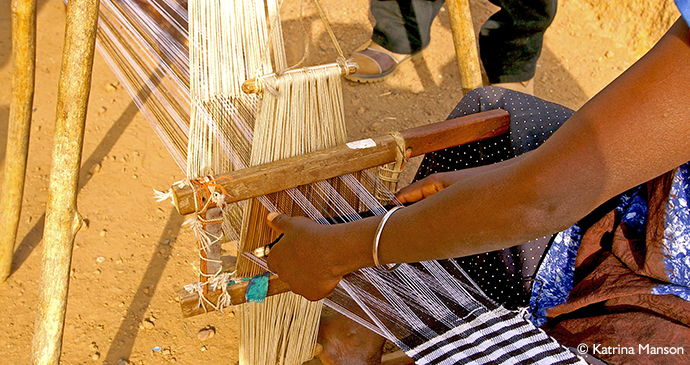
Kabala was once a major centre for weaving, although today it’s on the decline © Katrina Manson
Kabala
Mention Kabala to anyone in Salone and a visible look of relief, and quite possibly delight, generally passes over their face. It’s cold, they’ll say. And quiet. While it certainly doesn’t pass for Iceland, a cool breeze is pretty much guaranteed. Combine that with some fantastic walking trails amid lovely countryside and the town is a welcome respite for frazzled visitors seeking to escape the humidity and hustle of the coastal regions.
Containing Yalunka, Kuranko, Fula, Mandingo and Limba, it is really two towns in one – Kabala and Yogomaia. Local legend tells that the former got its name when in colonial times a European asked where on earth he was. He got the reply ‘Ka Bala’, meaning ‘Go and ask Bala’, who was obviously a knowledgeable sort of chap. The name made its way onto the map for good.
Kabala is not just a pretty place. The area is famed as the centre for the cattle-tending areas of the largely Muslim north, and its climate also puts it among the best sources of fresh produce in the country. The pressure for arable land and animal pasture has led to battles – both political and occasionally physical – between the Fula herders and traders on one side, and the sedentary farmers on the other, whose crops are regularly ruined by munch-hungry cows.
Another depressing irony in Kabala is that despite the quality of the land and the productivity of farmers, agricultural infrastructure is so ill-equipped for trade, refrigeration and storage that much of the booty heads straight off to the markets of Freetown where it will fetch a much better price, leaving the local markets bereft. ‘At times I have to send to Freetown for cucumber,’ says one cook in the town.
The local Limba chief, Chief Gbawura Mansaray III, can be met on his veranda sitting in a wooden throne with Queen Elizabeth II’s initials carved into it; he’s a good source of local knowledge, and happy to share some of it with visitors.
More striking than the town itself is the giant, looming black cliff next to it; it’s never quite clear whether it’s menacing the town or watching over it. Most of the fun in Kabala comes from striking out on long hikes to crest this and other hills of the surrounding countryside, stopping off at local villages along the way to ask directions or pick up a guide, and then returning to catch up with Kabala’s nightlife in the evenings.
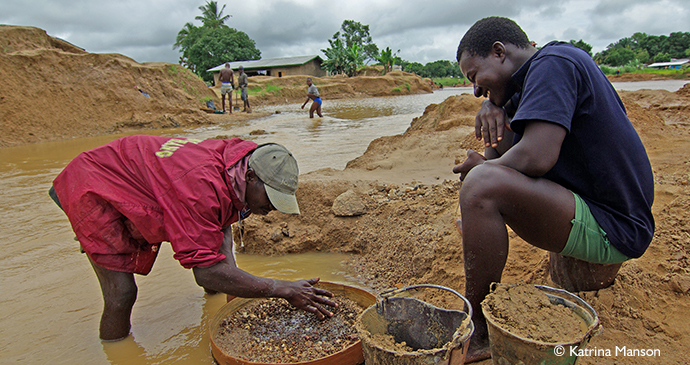 Head for the mining town of Koidu to see the hard graft that goes into hunting down the mythical big find © Katrina Manson
Head for the mining town of Koidu to see the hard graft that goes into hunting down the mythical big find © Katrina Manson
Koidu
Like gold-rush America, Sierra Leone’s diamond-mining capital can feel just as madly exciting, and just as desolate. Known as the Wild East, it has lured in many with the promise of riches, and yet the techniques employed are not much changed in 70 years. Next to pitifully scarred roads – a cruelly ironic reminder that mining rarely makes communities rich – men, and children, still scrabble around in pools of muddy, golden water with enormous pancake-like sieves, trawling the depths for a speck of something special. They can go months without finding anything.
Horribly pillaged during the war, Kono district became its shifting frontline, as factions and, later, UN troops vied for control of the lucrative diamond fields fuelling the violence. People dug up their roads, their gardens, even their floors in the hope of bagging a gem. Dusty and empty, the town feels eerily quiet on some days, exuberant on others. A babble of languages and nationalities – Australian, Russian, South African, Indian, Chinese, Israeli, Bulgarian, Korean – throng the late-night drinking dens to swap tales of success or despair, or lose themselves to the charms of the beer and local girls. The local Kono people (of the same name as the district) long ago lost their own control over the land – ethnicities from all parts of the country park themselves in Koidu in the hope of a bright spark. That gives the town some edge, particularly when politicians come touting for votes – it’s one of the few potential tinderboxes in the country.
There’s little shine to the town itself, however. It might be sitting on top of a big foreign-currency earner, but it’s a hardscrabble and hard-edged kind of place, with few obvious charms, though if nothing else, the roads are looking much better these days. Coffee and cocoa are regularly dried out in their tons on the roadsides during the dry season, and the weather is positively sweater-worthy from December to February, with chilly nights continuing well into the morning, even after the sun is up.
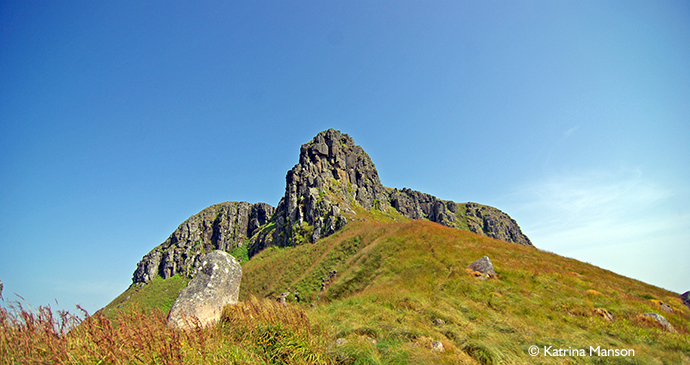
Climb the mist-shrouded peaks of Mount Bintumani © Katrina Manson
Mount Bintumani
The highest point in west Africa (well, west of Mount Cameroon’s 4,095m), Mount Bintumani isn’t known as the ’king of the mountains’ (‘Loma Mansa’ to the Kuranko) for nothing. Even finding yourself at the foot of its 1,948m, among the range of the Loma Mountains, takes some doing, and trying to manage an ascent in the rainy season approaches madness; not that people haven’t done it. Look out for Bintumani herself – the female spirit that lives on the mountain. There is more than one way to climb this mountain: you can scale the beast in a day if you’re dead set on speed; or seven, if you’re keener on taking your time, camping out in the wilderness, spotting herds of buffalo and trekking through rainforest that even the rebels didn’t reach.
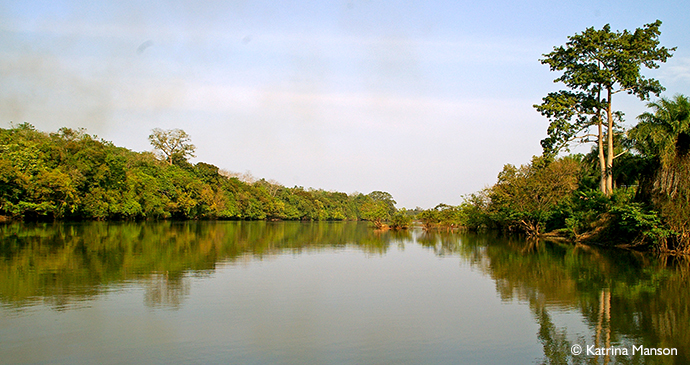
Head to Outamba-Kilimi National Park to canoe with hippos © Katrina Manson
Outamba-Kilimi National Park
In Outamba, a sighting or two of hippos, chimps and endangered monkeys is pretty much guaranteed, while the luckier may spot elephants and crocodiles, and researchers and some locals even talk of elusive leopards.
Skirting the Guinean border, it is in fact two parks for the price of one – Kilimi, with 243km² of savanna grasslands to the west, and Outamba (named after Mount Ukutamba, on the northern border of the park), more heavily wooded with 741km² to the east. There are bolilands too – large seasonally flooded areas – beside the Great Scarcies and Little Scarcies rivers (known locally as the Kolenten and Kaba). For the moment, unless visitors are particularly curious, exploration is limited to the Outamba side, where there is a basic campsite and guides. Kilimi, however, has two large lakes, and buffalo, waterbuck and bushbuck roam the savanna flatlands.
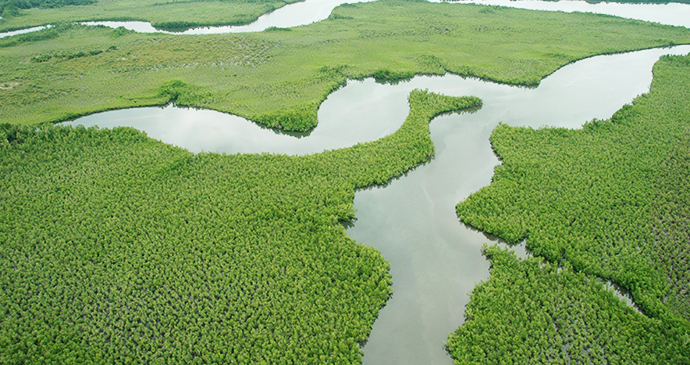 Sherbro Island is remote relaxation at its best © tormentor4555, Wikimedia Commons
Sherbro Island is remote relaxation at its best © tormentor4555, Wikimedia Commons
Sherbro Island
If parts of Sierra Leone seem isolated, Sherbro Island is the land that time forgot. No vehicles, hardly any noise, little but the birds to keep you company. Peculiar vestiges of a bygone age – defunct wrought-iron water hydrants, an old red telephone box, a smattering of tumbledown, long-abandoned shopfronts along the shoreline – only serve to reinforce how worn down and out of the way the island has become. Even Sierra Leoneans don’t want to live there: when a hopeful charity set up an amputee camp on the island following the end of the hostilities, the country’s war-wounded turned their noses up and refused to relocate.
Yet the island has a slow, easy charm borne of being about for donkey’s years, with no pretence. A world away from Freetown, it is a wonderful place to spend a couple of lazy hassle-free days, exploring by bicycle, and by boat. The real secret of the place, at least for the visitor, is not so much the island itself as the waters around it. You haven’t captured the spirit of Sherbro until you have cruised, perused, and meandered its waterways. These rivers, estuaries and the nearby Atlantic are its link to the rest of the world, supporting creaking wooden boats laden with commuters, tangled mangrove swamps and raffia trees, riverside rice plantations, and birds aplenty. Maribou storks and colonies of pelicans nest on the local shores, seabirds drop in, and kingfishers and tropical birds can be seen on inland sorties.
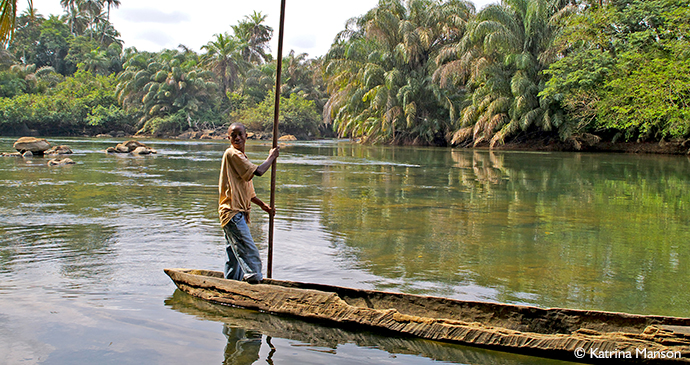
Tiwai Island as well as Gola and the Lorna Mountains are three of the last habitats for wild chimps in Sierra Leone © Katrina Manson
Tiwai Island
A visit to this tropical rainforest island is undoubtedly one of Sierra Leone’s wildlife highlights. Encircled by the slow-flowing waters of the Moa River you are immersed in the sights and sounds of one of the world’s densest and most diverse chimpanzee and monkey populations and more than 700 species of plant life, not to mention the pygmy hippo, a squat little nocturnal beast found only in Liberia, Ivory Coast, Guinea and Sierra Leone. It’s a pleasing adventure unmatched by anything else in the country – far from Freetown and, accessible only by motor launch, you camp in unusually good conditions. The name Tiwai might mean ‘big’ in Mende, but at 12km² (measuring 6km by 3km at its longest and widest points), it’s easy to make the island your own, and a rare chance to hole up in a corner of the Upper Guinea forest region of west Africa (one of 25 ‘biodiversity hotspots’ in the world), with the highest mammalian diversity of any tropical forest.
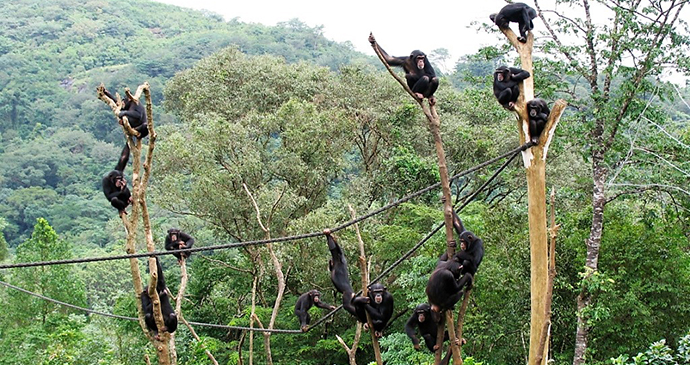 Even the least-animal friendly of visitors will get sucked into the magic of the chimps at the Tacugama Sanctuary located in the interior of the peninsula © Tacugama Chimpanzee Sanctuary
Even the least-animal friendly of visitors will get sucked into the magic of the chimps at the Tacugama Sanctuary located in the interior of the peninsula © Tacugama Chimpanzee Sanctuary
Western Area Peninsula
The Western Peninsula is like Sierra Leone in miniature – the holiday happiness of the ocean breeze, glorious rays, pristine beaches and cosy camp fires; rainforest reserves revealing chimps, rare birds and picnic-perfect waterfalls; the legacy of the coastal west African slave trade; and some of the best-preserved examples of the country’s Krio and Sherbro heritage.
On the wooded slopes of the Peninsula interior you can bathe in mountain pools, observe endangered primates close enough for them to biff you on the nose, and hike around the Western Area’s threatened forests. As for the coastline, all you have to do is indulge. For 40km. It provokes a little twitch of envy across the whole of west Africa, and visitors have been known to mutter about being in ‘tenth heaven’ as they set eyes on beach after beach, and dip toes in bathtub-warm water. Once the setting for a Bounty advert, these shores really do have a taste of paradise about them: bone-white sands stretching so far it feels like you could wander them forever; wooden boats bobbing on placid waters beneath forest-covered mountains disappearing into the mist; hammocks slung between trees on islands off the coast, perfect for lazy snoozing with only the bird for company; beachside villagers practising fishing and football. Give yourself some time, an appetite for fresh fish, lobster and oysters, and get out there.
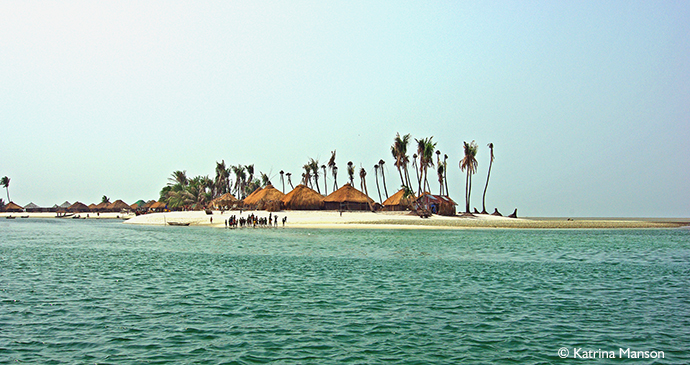
Turtle Islands
The stuff castaway movies are made of: eight tiny islands – Bakie, Bumpetuk, Chepo, Hoong, Mut, Nyangei, Sei and Yele – form the Turtle Islands, an undeveloped archipelago thrown across the Atlantic just off the western shore of Sherbro Island.
Each one is a slice of pure, bright sand sat amid breathtaking azure, framed by sighing palms silhouetted against a hazy blue sky. Still inhabited, the islands have their fair share of folklore. While the local paramount chief makes his home on Chepo Island, Hoong Island is strictly for initiated men. Women passing by in boats have been known to cover their heads in towels for fear of offending the spirits there, and they certainly never cast eyes on the island. Close to the western shore of Sherbro villages such as Tombe and Moyema, the islands have been described by one old-time resident as a place where the Sherbros ‘spend their evenings in groups, drinking and singing traditional songs of bravery and romance’.
Related books
For more information, see our guide to Sierra Leone:
Related articles
How many have you visited?
